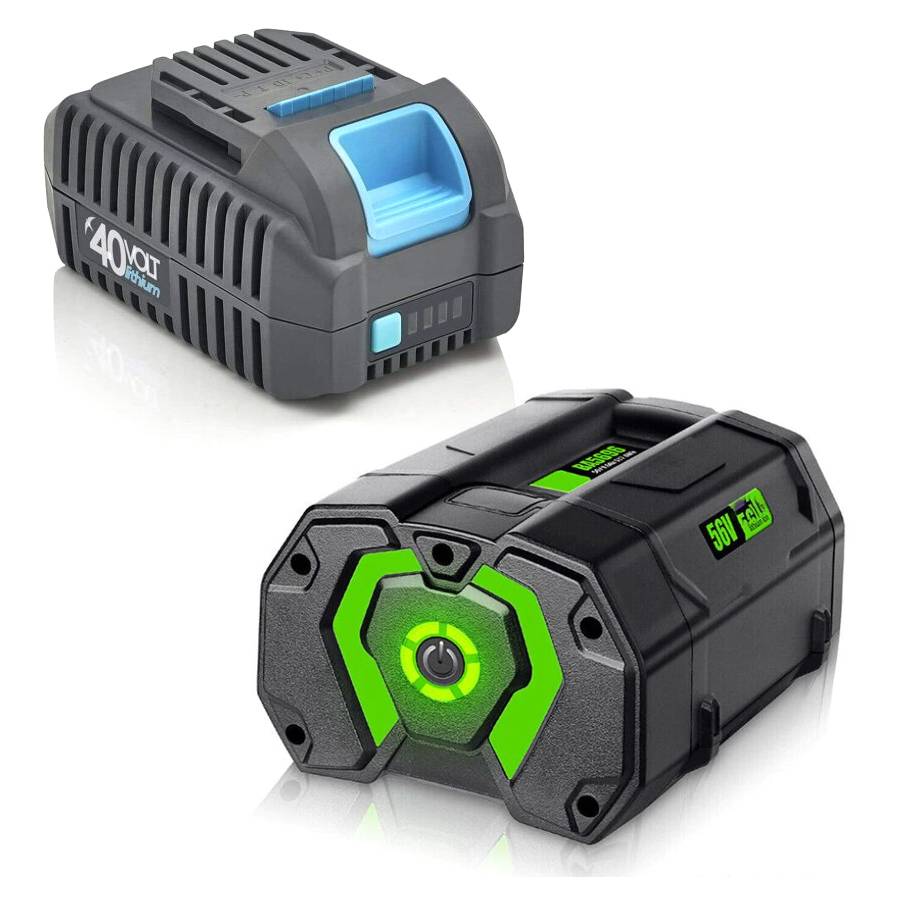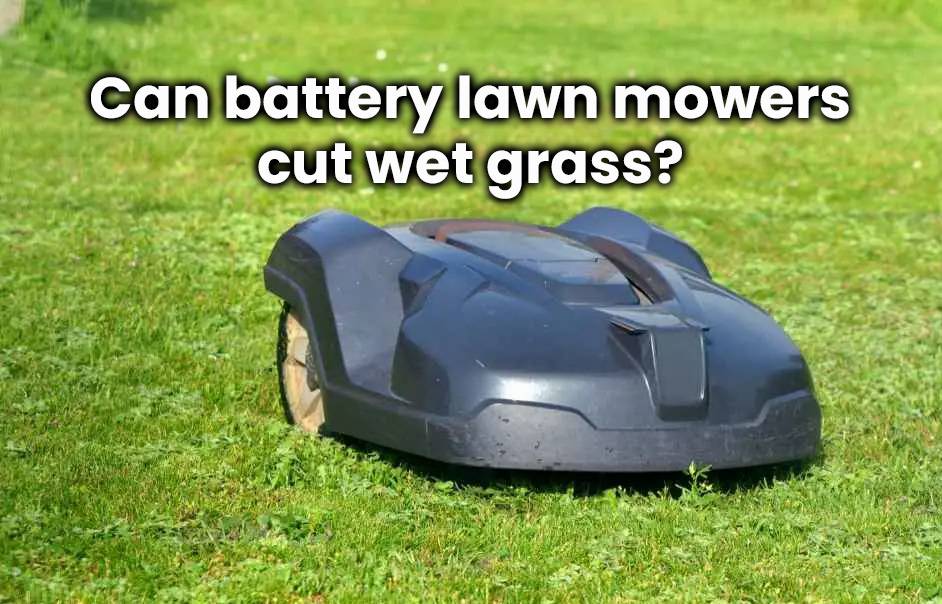No. Battery lawn mowers may struggle with wet grass due to clumping and increased weight. Gas-powered or corded electric mowers, along with robotic or manual reel mowers, offer better results for cutting damp grass. Consider factors like blade power and maintenance for optimal performance in wet conditions.
What makes wet grass difficult to cut?
Mowing wet grass presents challenges due to clumping, increased weight, buildup under the mower, and reduced traction. Wet grass sticks together, making clean cuts difficult, and the added weight strains the mower’s motor. Buildup underneath reduces cutting efficiency and poses clogging risks, while reduced traction increases the risk of slipping. Despite these challenges, proper precautions and maintenance can yield satisfactory results.
Key Points:
- Clumping Together: Wet grass tends to stick together, making it difficult for mower blades to cut cleanly. This results in uneven cutting and a less polished appearance.
- Increased Weight: Wet grass is heavier than dry grass, putting more strain on the mower’s motor and wheels. This extra weight can cause the mower to sink into the ground, making maneuvering tougher.
- Buildup Underneath: Wet grass easily sticks to the mower deck, reducing cutting efficiency and increasing the risk of clogging and damage to the mower.
- Reduced Traction: Mowing wet grass increases the likelihood of slipping or losing control due to reduced traction on slippery surfaces, posing safety risks for both the operator and the lawn.
Despite these challenges, proper precautions and maintenance can still lead to satisfactory results in damp conditions.
The impact of wet grass on battery lawn mowers
Wet grass poses challenges for battery lawn mowers, impacting performance and safety. Key issues include clumping, increased weight strain on the motor and battery, potential clogging, and electrical hazards. Adhering to safety guidelines is crucial. Consider these factors before mowing wet grass to ensure optimal performance and minimize risks of damage or accidents.
Key Points:
- Clumping Challenge: Wet grass tends to clump, making it difficult for mower blades to cut smoothly. This results in uneven and patchy cuts, leaving the lawn looking messy.
- Added Weight Strain: Wet grass is heavier, putting extra strain on the mower’s motor and battery. This added weight can compromise overall performance and cutting ability.
- Clogging Concerns: Wet grass sticks to the mower’s undercarriage, leading to clogging and reduced airflow. This compromises efficiency and can potentially cause damage if not addressed promptly.
- Electrical Hazards: Using a battery-powered mower on wet grass increases the risk of electrical hazards due to moisture exposure. Adhering to safety guidelines is crucial when operating electrical equipment in damp conditions.
Considering these factors is essential before mowing a lawn after rainfall or during periods of high humidity, ensuring optimal performance and safety.
Factors to consider when buying a battery lawn mower for wet grass
When buying a battery lawn mower for wet grass, prioritize blade power, runtime suitable for yard size, lightweight maneuverability, height adjustment options, and easy maintenance. These factors ensure efficient cutting in challenging wet conditions, providing optimal performance for your lawn care needs.

Key Points:
- Blade Power: Prioritize mowers with powerful cutting blades for tackling tough, wet grass efficiently. Sharp and robust blades are essential for a clean and effective cut.
- Runtime for Your Yard: Consider the size of your yard and opt for a battery mower with a longer runtime for larger areas. This ensures you can complete the job without frequent interruptions for recharging.
- Weight and Maneuverability: Choose a mower that is lightweight and easy to maneuver to navigate slippery surfaces caused by wet grass. This enhances safety and ease of use during operation.
- Height Adjustment Options: Check for height adjustment settings to accommodate different grass types. Ensure the mower offers flexibility in cutting heights to suit the specific needs of your lawn.
- Easy Maintenance: Look for a battery lawn mower that is easy to clean and maintain after use on wet grass. Simple maintenance routines contribute to a longer lifespan and consistent, optimal performance in all conditions.
By considering these factors, you can confidently select a battery lawn mower that meets your specific needs, providing efficient cutting even in challenging wet grass conditions.
Tips for mowing wet grass with a battery lawn mower
When mowing wet grass with a battery lawn mower, wait for it to dry slightly, adjust cutting height higher to prevent clogging, clear debris, mow slowly and thoroughly, and clean the mower after each use. These tips optimize performance and ensure a well-groomed yard, though limitations may occur in extremely wet conditions.
Key Tips:
- Timing Matters: Choose the right time to mow wet grass by waiting until it has dried slightly. This makes the task easier, ensuring a cleaner cut and better mower performance.
- Adjust Cutting Height: When dealing with wet grass, set your mower at a higher cutting height to prevent clogging and reduce strain on the motor. This adjustment enhances overall efficiency.
- Clear Debris: Remove any debris such as leaves or twigs from the lawn before mowing. Wet grass clings together easily, and a clear surface helps prevent clogs, ensuring an even and smooth cut.
- Slow and Thorough: Mowing wet grass requires patience. Take it slow, make overlapping passes, and ensure thorough coverage to minimize clumping and achieve a well-groomed appearance.
- Post-Mow Cleanup: Clean off excess moisture and debris from your battery lawn mower after each use on wet grass. This routine maintenance contributes to a longer lifespan and ensures smooth operation for future use.
Keep in mind that while battery lawn mowers handle damp conditions well, they may have limitations in extremely wet situations. Follow these tips to maximize the performance of your battery mower and maintain a well-groomed yard year-round.
Alternatives to using a battery lawn mower for wet grass
Alternatives to battery lawn mowers for wet grass include gas-powered mowers, corded electric mowers, robotic mowers, and manual reel mowers. Gas mowers offer robust performance, while electric options provide eco-friendly operation. Robotic mowers offer hands-off maintenance, and manual reel mowers suit small yards. Consider these alternatives based on your lawn’s needs for efficient wet grass cutting.
Key Alternatives:
- Gas-Powered Mowers: With more power, gas-powered mowers handle wet grass effortlessly, thanks to robust engines and sharp blades. They power through moisture without clogging or stalling.
- Corded Electric Mowers: For an eco-friendly option without the hassle of fueling or charging, corded electric mowers provide consistent power when plugged into an outlet, effectively cutting through damp grass.
- Robotic Mowers: Offering convenience and efficiency, robotic mowers with rain sensors and enhanced traction features can handle moist surfaces. Some models are designed for wet grass cutting, providing a hands-off approach to lawn maintenance.
- Manual Reel Mowers: Going back to basics, manual reel mowers are suitable for small yards or those who enjoy some exercise while mowing. These simple, motor-free mowers work well on wet grass without the risk of clogging.
In conclusion, while battery lawn mowers may not always be ideal for wet grass, advancements in technology continue to improve their performance. Consider alternative options based on your specific needs and the characteristics of your lawn to ensure efficient and effective cutting.

